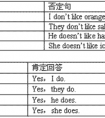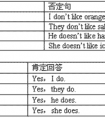单句改错。1. Restaurant owners should know how to make customers to spend more money.__________________________________________________2. People only sit for -九年级英语
The rich sometimes complain their empty life. 富人有时抱怨他们空虚的生活。
The police led the old man across the street. 警察领老人横过马路。
以-ly结尾的形容词
1) 大部分形容词加-ly可构成副词。但 friendly,deadly,lovely,lonely,likely,lively,brotherly,仍为形容词。
改错:(错) She sang lovely. (错) He spoke to me very friendly.
(对) Her singing was lovely. (对) He spoke to me in a very friendly way.
2)有些以-ly 结尾的词既为形容词,也为副词。
daily,weekly,monthly,yearly,early
The Times is a daily paper.
The Times is published daily.
too+adj.+to句型 “太…而不能”
He is too young to go to school.
=He isn’t old enough to go to school.
=He is so young that he can’t go to school.
形容词的位置:
1.形容词一般放在名词前作定语?
单个形容词修饰名词时,一般要放在名词的前面。它们的前面常常带有冠词、形容词性物主代词、指示代词、数词等。例如:?
a red flower一朵红花?
an interesting story一个有趣的故事?
six blind men 六个盲人?
my own house我自己的房子?
如果有两个或两个以上的形容词修饰一个名词时,则由它们和被修饰的名词之间的密切程度而定,越密切的形容词越靠近名词。
如果几个形容词的密切程度差不多则按音节少的形容词放在前面,音节多的形容词放在后面。
2.当形容词所修饰的词是由some,any,every,no等构成的不定代词时,形容词必须置于名词之后。例如:?
She has something new to tell me.?她有一些新的情况告诉我。?
I have nothing important to do today.?今天我没有重要的工作要做。?
Do you know anybody else here??这儿你还有认识的人吗??
3.形容词后面有介词短语或不定式短语时,形容词必须置于名词之后。例如:?
It is a problem difficult to work out.?这是一道难以解决的问题。?
Edison is a student difficult to teach.?爱迪生是个很难教的学生。?
This is a kind of flowers easy to grow.?这是一种易栽的花。?
4.用 and 或 or 连接起来的两个形容词作定语时一般把它们放在被修饰的名词后面。起进一步解释的作用。例如:?
All people,young or old,should be strict with themselves.?
所有的人,无论老少,都应该严格要求自己。?
We are building a new school, modern and super.?
我们正在建一所现代化的高档次的新型学校。?
All countries, rich and poor, should help one another. 所有的国家,无论穷富都应该互相帮助。?
5.有少数形容词,如enough和possible,既可置于所修饰的名词前面也可以置于它所修饰的名词之后。例如:?
Do you have enough time(time enough)to prepare?你有足够的时间做准备吗??
Maybe it will be a possible chance(chance possible)for you.或许它将成为一次可能的机遇。
6.有些形容词,置于名词之前与之后,含义不尽相同。例如:?
the writer present 出席的作者?
the present writer 现在的作者?
7.表示长,宽,高,深,及年龄的形容词,应放在相应的名词之后。
This river is about 100 metres wide.
The building is more than 50 metres tall.
He is less than 40 years old.
8. enough修饰名词时,在名词前后都可以。
They said that they had enough food.= They said that they had food enough.
enough 修饰形容词和副词,位于其后。
He is old enough to join the army.
He isn’t old enough to go to school.
9.形容词else通常放在疑问代词,疑问副词或不定代词后
what/who/where/when/when else
something/anything/nothing…else
What else did you do?
Do you have anything else to say?
10.由两个或两个以上的词组成的形容词词组修饰名词时须放在名词之后。
This is the book easy to read.
这是一本容易读的书。
名词化的形容词:
有些形容词可以和定冠词连用,表示一类人或事物,这时,它相当于一个名词,可作主语或宾语;
表示一类人时,看作复数,表示一类事物时,通常看作单数。
Robin Hooh(罗宾汉) hated the rich and loved the poor.
The old are taken good care of in American.
the+形容词,常见的短语有:
the old/the young/the sick/the white/
the black/the rich/the poor/the dead(死者)
形似副词的形容词:
以-ly结尾的词通常是副词,但是下列词为形容词。
friendly lonely (孤独的) ;lively (活着的);lovely(可爱的)
复合形容词的类型:
(1)名词+过去分词 man-made satellite 人造卫星
(2)形容词+现在分词 a good-looking man
(3)形容词+名词 second-hand cars
(4)数词+名词-ed three-legged chairs三条腿的椅子
(5)数词+名词 400- metre race
(6)副词+现在分词 hard-working students
(7)副词+过去分词 well-known writers
(8)形容词+形容词 a dark-red jacket
(9)形容词+过去分词 ready-made clothes 成品服装
含有形容词的常用句型:
(1) It’s+adj. of sb. to do sth.
(good/ kind/nice/polite/clever/foolish… )
It’s very kind of you to help me.
(2) It’s +adj. for sb. to do sth.
(difficult/easy/hard/dangerous/usefulinteresting/important…)
It’s important for us to learn English well.
(3)下列形容词后常跟动词不定式
表示情感或情绪的形容词:glad,pleased,sorry,sad,afraid,thankful…
I'm glad to see you.
表示能力,意志或推测的形容词:ready,able,sure,certain…
I’m sorry to hear that.
某些现在分词和过去分词可作形容词
the moving story 令人感动的故事
a moved boy 一个被感动的男孩
a frightened child 一个被吓到的孩子
a frightening film 一个恐怖电影
考点名称:介词短语
- 介词短语:
介词是一种用来表示词与词, 词与句之间的关系的词。在句中不能单独作句子成分。
介词后面一般有名词代词或相当于名词的其他词类,短语或从句作它的宾语。介词与它的宾语构成介词词组,在句中作状语,表语,补语,定语或介词宾语。例如:at ,in, on, to
介词短语在句中可以作状语,定语,表语,补足语等。
1. 作表语
例如:It was in 2005 in Beijing.
2. 作宾语补足语
例如:He found his dog outside the station.
3. 作后置定语
例如:I even store them in boxes under my bed.
4. 作状语
例如:You are supposed to put your bread on your plate. - 常见介词用法:
1)at,in,on在……范围
at (1)表示在小地方; (2)表示“在……附近,旁边”
in (1)表示 在大地方; (2)表示“在…范围之内”。
on 表示毗邻,接壤
to 表示在……范围外,不强调是否接壤
He arrived at the station at ten.
He is sitting at the desk.
He arrived in Shanghai yesterday.
Jiangsu lies in the east of China.
Russia live on the north of China.
Fujian is to the south of Jiangsu Province.
2)above, over, on 在……上
above 指在……上方,不强调是否垂直,与 below相对;
over指垂直的上方,与under相对,但over与物体有一定的空间,不直接接触。
on表示某物体上面并与之接触。
The bird is flying above my head.
There is a bridge over the river.
He put his watch on the desk.
3)below, under 在……下面
under表示在…正下方
below表示在……下,不一定在正下方
There is a cat under the table.
Please write your name below the line. 介词短语组织形式及实例:
一、介词+名词形式
第一组
by accident 偶然
on account of 因为,由于
in addition 另外
in addition to 除 …… 之外
in the air 在流行中,在传播中
on (the/an) average 平均,一般来说
on the basis of 根据,在 …… 的基础上
- 最新内容
- 相关内容
- 网友推荐
- 图文推荐
| [家长教育] 孩子为什么会和父母感情疏离? (2019-07-14) |
| [教师分享] 给远方姐姐的一封信 (2018-11-07) |
| [教师分享] 伸缩门 (2018-11-07) |
| [教师分享] 回家乡 (2018-11-07) |
| [教师分享] 是风味也是人间 (2018-11-07) |
| [教师分享] 一句格言的启示 (2018-11-07) |
| [教师分享] 无规矩不成方圆 (2018-11-07) |
| [教师分享] 第十届全国教育名家论坛有感(二) (2018-11-07) |
| [教师分享] 贪玩的小狗 (2018-11-07) |
| [教师分享] 未命名文章 (2018-11-07) |


![How much does it ______ to fly from Yancheng to Hainan Island?[ ]A. cost B. payC. spend D. take-七年级英语](http://www.00-edu.com/d/file/ks/4/2/shiyidongci/2020-01-05/small7dcf2f05998de63e10cc3629787031c81578210087.png)

![He always _____TV in the evening. He _____ listening to the radio. [ ]A. watch, don't like B. watches, doesn't like C. watching, don't like D. watch, do-七年级英语](http://www.00-edu.com/d/file/ks/4/2/shiyidongci/2020-01-05/small45d599b4a60b84e61cec210bfbf051f51578214524.png)
![I'd rather ___ to the Mcdonald's Restaurant because I like to listen to quiet music.[ ]A. to go B. going C. go D. went-八年级英语](http://www.00-edu.com/d/file/ks/4/2/shiyidongci/2020-01-05/small1767bba1727fef2c035c53dcbd9bc20e1578209517.png)
